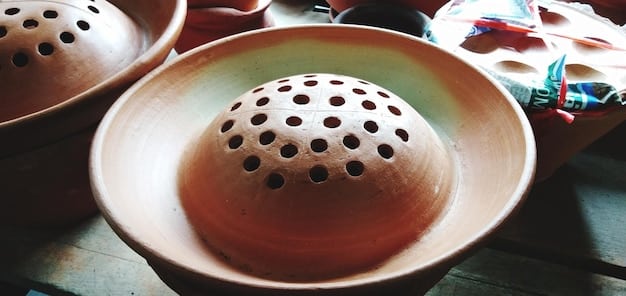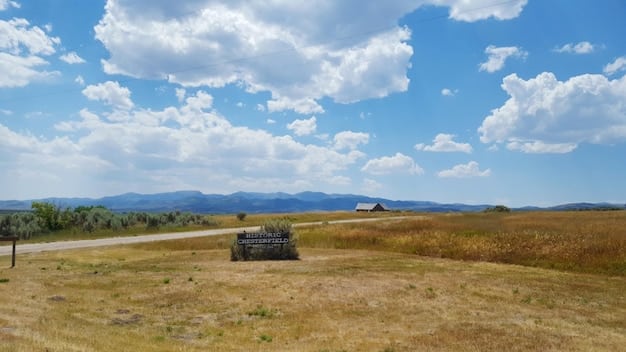Discover Native American Heritage: A Travel Guide

Anúncios
Discover America’s Indigenous Cultures: A Respectful Travel Guide to Native American Heritage Sites offers a curated journey through significant historical locations, emphasizing respectful engagement and cultural preservation across the United States.
Embark on a journey of cultural enrichment as you Discover America’s Indigenous Cultures: A Respectful Travel Guide to Native American Heritage Sites. This guide provides insight into preserving Native American traditions, histories, and sacred places.
Anúncios
Understanding and Respecting Indigenous Cultures
Traveling to Native American heritage sites provides a unique opportunity to learn about the rich history and contemporary lives of Indigenous peoples. However, it’s crucial to approach these sites with respect, sensitivity, and a genuine desire to understand.
Understanding cultural nuances is critical for ethical travel within indigenous lands.
Anúncios
Importance of Cultural Sensitivity
When visiting Native American heritage sites, it’s important to remember that you’re entering spaces of cultural and historical significance. Cultural sensitivity goes beyond mere etiquette; it involves actively respecting the values, traditions, and beliefs of the people whose heritage you are exploring.
- Be mindful of photography restrictions, as some ceremonies or locations may be considered sacred and not suitable for photography.
- Avoid making assumptions about Indigenous cultures based on stereotypes or popular media portrayals. Instead, seek accurate information from reliable sources, such as tribal museums, cultural centers, and educational programs.
- Support Indigenous-owned businesses and initiatives whenever possible, as this directly contributes to the economic well-being of Native American communities.
Engaging respectfully also means recognizing the diversity among different Native American tribes and nations. Each has its own unique history, language, and cultural practices, and generalizations should be avoided to promote better understanding.

Planning Your Trip to Native American Heritage Sites
Planning a trip to explore Native American heritage sites requires careful consideration and research. The goal is to ensure that your visit not only enriches your understanding of Indigenous cultures, but also minimizes any potential negative impact on these communities and their sacred sites.
Selecting wisely where to go and understanding when it is best helps to reduce the negative impacts.
Choosing the Right Destinations
With a wide array of options, selecting the right Native American heritage sites to visit can be both exciting and challenging. Consider focusing on sites that offer interpretive programs and cultural centers, as they often provide valuable insights and perspectives that might not be available elsewhere.
- Research the specific tribes or nations associated with the sites you plan to visit, and learn about their history, culture, and contemporary issues.
- Look for opportunities to engage with Indigenous guides or cultural ambassadors, as they can offer firsthand perspectives and insights that enrich the experience.
- Consider visiting during cultural events or festivals, as these provide opportunities to witness traditional ceremonies, dances, and other cultural expressions.
Planning your route is also an excellent opportunity to include Native American-owned accommodations or tour operators to support local businesses and promote sustainable tourism practices.
Exploring Key Native American Heritage Sites
The United States is home to numerous Native American heritage sites, each offering a unique glimpse into the diverse histories and cultures of Indigenous peoples. These sites range from ancient villages and burial mounds to battlefields and cultural centers, providing a comprehensive overview of Native American history.
Visiting is an immersive way to deeply learn about the varied pasts that form modern America.
Mesa Verde National Park, Colorado
Mesa Verde National Park is renowned for its well-preserved Ancestral Puebloan cliff dwellings, showcasing the ingenuity and architectural skills of this ancient civilization. Visitors can explore these dwellings, learn about the daily lives of the Ancestral Puebloans, and gain insights into their cultural practices and beliefs.
Cahokia Mounds State Historic Site, Illinois
Cahokia Mounds State Historic Site is the largest pre-Colombian settlement north of Mexico, offering a glimpse into the sophisticated Mississippian culture that thrived in the region centuries ago. Visitors can explore the massive earthen mounds, learn about the Cahokia people, and gain insights into their social organization, religious beliefs, and agricultural practices.

Ethical Considerations for Visiting Sacred Sites
When visiting Native American heritage sites, especially those considered sacred, it’s essential to approach the experience with a deep sense of respect and humility. Sacred sites often hold profound spiritual significance for Indigenous people, and visitors should be mindful of their actions and behaviors.
Understanding the site and avoiding offense promotes a better experience and protects these locations.
Understanding the Significance of Sacred Sites
Sacred sites may include burial grounds, ceremonial sites, natural landmarks, and other locations that hold spiritual or cultural importance for Indigenous people. These sites are often considered to be living entities, imbued with the presence and power of ancestors and spirits.
- Follow all guidelines and regulations established by tribal authorities, including restrictions on access, photography, and behavior.
- Avoid touching or disturbing artifacts, plants, or other natural features, as this can disrupt the spiritual balance of the site.
- Be mindful of your language and tone, avoiding disrespectful or dismissive remarks about Indigenous cultures or beliefs.
Respecting sacred sites contributes to the preservation of cultural heritage and promotes reconciliation between Indigenous and non-Indigenous communities.
Supporting Native American Communities Through Tourism
Tourism can be a powerful tool for supporting Native American communities, but it’s essential to ensure that tourism practices are sustainable and respectful of Indigenous cultures and values. By making informed choices about where to visit and how to engage with Native American communities, visitors can contribute to economic development, cultural preservation, and self-determination.
Actively participating in and promoting this type of tourism can benefit both parties.
Choosing Indigenous-Owned Businesses
One of the most effective ways to support Native American communities through tourism is to patronize Indigenous-owned businesses, such as hotels, restaurants, tour operators, and art galleries. These businesses provide employment opportunities for Native American people, generate revenue for tribal governments, and promote cultural exchange and understanding.
- Research the specific ownership structure of businesses to ensure that they are genuinely Indigenous-owned and operated.
- Look for businesses that prioritize sustainability and environmental responsibility, as this aligns with traditional Indigenous values.
- Be prepared to pay fair prices for goods and services, recognizing the value of Indigenous knowledge, skills, and cultural heritage.
By supporting Native American communities through tourism, visitors can help create a more equitable and sustainable future for Indigenous peoples.
The Future of Responsible Indigenous Tourism
Responsible Indigenous tourism is not just a trend, but a growing movement towards ethical and sustainable travel practices that respect and benefit Native American communities. As awareness of Indigenous cultures and histories grows, so too does the demand for authentic and meaningful travel experiences that prioritize cultural preservation, economic development, and self-determination.
Together we create a space for sharing, respecting, and helping others reach their full potential.
Embracing Collaboration and Partnership
The future of responsible Indigenous tourism depends on collaboration and partnership between Native American communities, tourism operators, government agencies, and visitors. By working together, these stakeholders can create tourism models that are mutually beneficial, sustainable, and respectful of Indigenous cultures and values.
- Engage in ongoing dialogue and consultation with Native American communities to ensure that tourism initiatives align with their priorities and aspirations.
- Develop educational resources and training programs to promote cultural awareness and sensitivity among tourism operators and visitors.
- Advocate for policies and regulations that protect Indigenous cultural heritage and promote sustainable tourism practices.
The path forward for Indigenous tourism is one of shared responsibility and collective action, and will lead to a journey of understanding, respect, and reconciliation.
| Key Point | Brief Description |
|---|---|
| 🏞️ Respect Indigenous Cultures | Approach sites with sensitivity, respect, and a genuine desire to understand. |
| 🗺️ Plan Your Trip | Research sites, engage with Indigenous guides, and consider cultural events during your visit. |
| 🤝 Support Communities | Patronize Indigenous-owned businesses to contribute to economic development. |
| 🛡️ Ethical Considerations | Understand the significance of sacred sites and follow guidelines established by tribal authorities. |
Frequently Asked Questions
▼
Respecting Indigenous cultures acknowledges their historical significance and ensures the preservation of traditions. It promotes ethical tourism and fosters positive relationships between travelers and Indigenous communities.
▼
You can support Native American communities by choosing Indigenous-owned businesses like hotels, restaurants, and tour operators. This directly contributes to their economic well-being and cultural preservation efforts.
▼
Some key sites include Mesa Verde National Park and Cahokia Mounds State Historic Site. These locations offer insights into the ancient civilizations and cultures of Native American peoples.
▼
When visiting sacred sites, adhere to all guidelines provided by tribal authorities. Avoid disturbing artifacts or natural features, and be mindful of your language and behavior to show respect.
▼
Tourism can promote reconciliation by raising awareness of Indigenous cultures and histories. By engaging respectfully and supporting Indigenous initiatives, you contribute to a more equitable and sustainable future.
Conclusion
By embracing responsible travel practices and showing respect for Indigenous cultures, we can enrich our understanding of America’s diverse heritage and support the well-being of Native American communities for generations to come. Let’s prioritize appreciation, respect, and collaboration in our explorations to foster a future of understanding and reconciliation.





